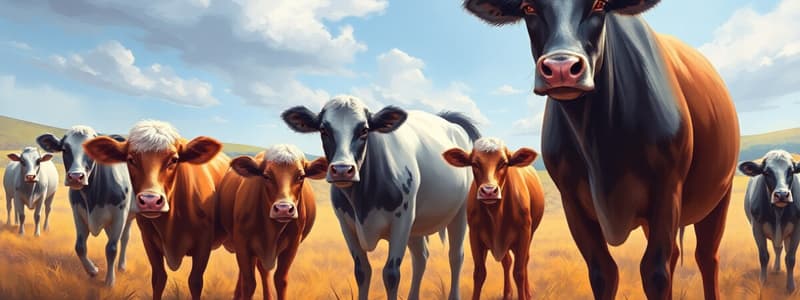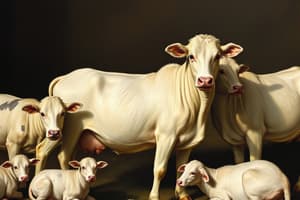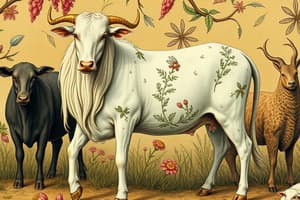Podcast
Questions and Answers
ما هي الفائدة الرئيسية من تربية الماشية مثل الأبقار؟
ما هي الفائدة الرئيسية من تربية الماشية مثل الأبقار؟
- إنتاج اللحوم فقط
- إنتاج الحليب واللحوم (correct)
- توفير الألياف فقط
- إنتاج الحليب فقط
أي من الحيوانات التالية يُعد من الدواجن؟
أي من الحيوانات التالية يُعد من الدواجن؟
- الأبقار
- الدجاج (correct)
- الخراف
- البقر
أي من العوامل التالية يعدّ جزءًا من إدارة الحيوان في المزرعة؟
أي من العوامل التالية يعدّ جزءًا من إدارة الحيوان في المزرعة؟
- بيع الحيوانات فقط
- التسويق في السوق
- جمع البيض من الدجاج
- احتياجات الحيوانات الغذائية (correct)
كيف تؤثر برامج الاختيار والتربية على مواشي المزرعة؟
كيف تؤثر برامج الاختيار والتربية على مواشي المزرعة؟
أي من الحيوانات التالية تُستخدم لدعم الزراعة من خلال دورها كحيوانات حراسة؟
أي من الحيوانات التالية تُستخدم لدعم الزراعة من خلال دورها كحيوانات حراسة؟
ما هو الهدف الرئيسي من الزراعة المائية؟
ما هو الهدف الرئيسي من الزراعة المائية؟
أي من العوامل التالية له تأثير مباشر على الإنتاجية في المزرعة؟
أي من العوامل التالية له تأثير مباشر على الإنتاجية في المزرعة؟
ما هي السمة الرئيسية لبعض أنواع الأغنام في المزرعة؟
ما هي السمة الرئيسية لبعض أنواع الأغنام في المزرعة؟
Flashcards
الحيوانات الأليفة
الحيوانات الأليفة
الحيوانات الأليفة التي يتم تربيتها لأغراض متنوعة مثل إنتاج الغذاء والعمل والرفقة.
المواشي
المواشي
أنواع الحيوانات الأليفة التي تُربى للحصول على الحليب أو اللحم.
الدواجن
الدواجن
أنواع الحيوانات الأليفة التي تُربى لانتاج البيض أو اللحم.
الأبقار
الأبقار
Signup and view all the flashcards
الخنازير
الخنازير
Signup and view all the flashcards
الأغنام
الأغنام
Signup and view all the flashcards
الماعز
الماعز
Signup and view all the flashcards
الزراعة المائية
الزراعة المائية
Signup and view all the flashcards
Study Notes
Farm Animal Classification and Types
- Farm animals are domesticated animals raised for various purposes, including food production, labor, and companionship.
- Common categories include livestock (e.g., cattle, pigs, sheep), poultry (e.g., chickens, turkeys), and aquaculture (e.g., fish, shellfish).
- Specific breeds within each category often exhibit variations in traits like size, temperament, and productivity.
- Selection and breeding programs have led to variations in traits like body size, milk production, meat yield, and egg production.
Livestock: Cattle, Pigs, Sheep, and Goats
- Cattle: Primarily raised for meat (beef) and milk (dairy). Different breeds are specialized for either beef or dairy production.
- Pigs: Raised for meat production. Breeds vary in size and muscle composition.
- Sheep: Raised for meat (mutton), wool, and sometimes milk (cheeses).
- Goats: Raised for meat, milk (cheese and yogurt), and fiber (mohair).
Poultry: Chickens, Turkeys, Ducks, and Geese
- Chickens: The most common poultry for meat and eggs. Different breeds have varying egg-laying rates and meat yields.
- Turkeys: Primarily raised for meat production. Relatively large birds with high meat yields.
- Ducks: Raised for meat, eggs, and in some cases, for their role as pest control.
- Geese: Raised for meat, but also as guard animals and for their ability to graze.
Aquaculture
- Aquaculture involves farming aquatic organisms such as fish, shellfish (oysters, shrimp, clams), and other aquatic plants.
- Farmers control the environment, feeding, and breeding to optimize production.
- Aquaculture has grown significantly for providing food sources in a controlled manner versus relying on wild populations.
Farm Animal Management
- Feeding: Provision of necessary nutrients to maintain health, growth, and productivity. Diets vary based on species, age, stage of production, and breed.
- Housing: Maintaining appropriate living conditions, including shelter from extreme temperatures, sufficient space, and hygienic conditions.
- Breeding and Reproduction: Control breeding programs to maintain optimal health and productivity. Selective breeding is important in achieving desirable traits.
- Health Management: Prevention and control of diseases and parasites are critical. Veterinary care and preventive measures are essential aspects of farm animal management.
Ethical Concerns and Welfare
- Animal welfare is a growing concern within the farm animal industry.
- Ensuring adequate space, freedom of movement, protection from stress, and humane slaughter processes are important ethical considerations.
- Recent regulations and guidelines are focusing on maximizing animal well-being in farm environments.
Economic Importance
- Farm animals are a significant source of food and agricultural revenue globally.
- They play a crucial role in the economy of many countries, impacting livelihoods and trade.
- The production and processing of farm animals represent a major part of agricultural output.
Studying That Suits You
Use AI to generate personalized quizzes and flashcards to suit your learning preferences.




